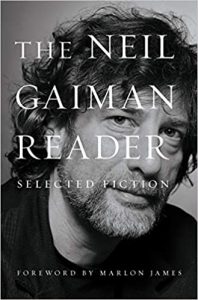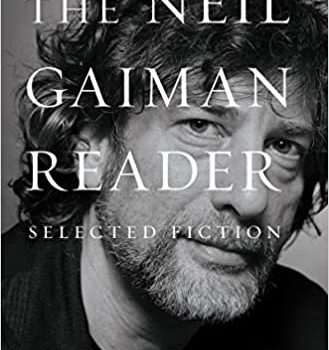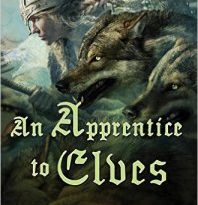Gary K. Wolfe Reviews The Neil Gaiman Reader by Neil Gaiman
 The Neil Gaiman Reader, Neil Gaiman (William Morrow 978-0-06-303185-2, $40.00, 736pp) October 2020.
The Neil Gaiman Reader, Neil Gaiman (William Morrow 978-0-06-303185-2, $40.00, 736pp) October 2020.
The selections in The Neil Gaiman Reader were chosen neither by an outside editor nor by Gaiman himself, as he did with his earlier collections. Instead, apparently, the book was edited by the internet. In 2019, Gaiman invited his readers to name their three favorite Gaiman stories, and the result – from nearly 6,000 responses, we are told – was this selection of 52 short pieces, ranging from short sketches to major novellas, supplemented by five excerpts from novels. It probably says something about Gaiman’s popularity that so many readers would be familiar with his short fiction, but then his short fiction has been more widely visible than almost anyone else’s over the last quarter century or so (in addition to appearances in earlier collections, some 15 of these stories have been published in standalone chapbooks). Fortunately, the result is as varied and rewarding as if Gaiman himself had made the choices, and that’s a tribute not necessarily to his loyal readers, but to the fiction itself.
Previous Gaiman collections (and even to a certain extent his novels) have conveyed not only a palpable sense of celebration of that Cauldron of Story mentioned earlier, but an almost curatorial sense as well, as though he were acutely aware of the mantle he’d inherited. Though his own voice is distinctive, he loves sampling the voices of writers and works he wants you to appreciate (even through parody, on occasion), as made apparent in his entertaining story notes in those earlier collections (a habit he might have picked up from Harlan Ellison, whose liner notes could be more interesting than the stories themselves). Probably because the book already strains the ligaments at 736 pages, no such notes appear in The Neil Gaiman Reader. Thus, it’s up to the reader to suss out that “Sunbird” is a tribute to R.A. Lafferty, complete with oddball character names and quirky style; that “Strange Little Girls” began as vignettes to accompany a Tori Amos album; that “A Lunar Labyrinth” honors Gene Wolfe; or that “Return of the Thin White Duke” is a sort of fan-fiction origin story for David Bowie. Fortunately, most of such tales are self-contained enough to work well even without the gloss, and seldom does a Gaiman story strike only one note. The delightful “Sunbird”, for example, may echo Lafferty with its language and characters, but in form it fits in with the club stories that pepper the volume, and its account of a jaded gourmet society that decides it needs to eat a Phoenix makes it one of the funniest pieces in the book.
That habit of making stories do double or triple duty is another Gaiman trademark. Long before Lovecraft became everyone’s favorite hate-watching rehab project, Gaiman was focusing not on HPL’s odious personal attitudes, but on the odd mix of genuine terror and abject silliness of his mythos. “I, Cthulhu” is a slight but entertaining comic monologue with the big C himself petulantly complaining to Lovecraft’s Wilbur Whateley, while “Only the End of the World Again” brings Lawrence Talbot from The Wolf Man to a decaying Innsmouth of seedy bars and trailer parks, where he almost inadvertently foils a plan to reawaken the Deep Ones. “A Study in Emerald” begins as a familiar Sherlock Holmes pastiche, but is so packed with pop-Victorian jellybeans (tiny Easter eggs, as an eight-year-old once explained to me) that we quickly realize we’re in an alternate history in which, it turns out, the Elder Gods have long since conquered Europe, and Victoria herself is a tentacled monstrosity. It’s a hoot (as well as a pretty good imitation of Doyle, though the elegiac “The Case of Death and Honey” is a more serious reconsideration of Holmes mythology). Easily the funniest of the Lovecraft japes is “Shoggoth’s Old Peculiar”, in which an American wandering around rural England (another recurring Gaiman trope) finds himself in a village called Innsmouth (supposedly HPL’s New England town was named after it), where a couple of local Cthulhu-worshipers complain about Lovecraft’s language in banter that sounds like nothing so much as Peter Cook and Dudley Moore in one of their ancient pub sketches.
Two stories serve as tributes to another favorite writer, Ray Bradbury. “October in the Chair”, whose very title seems an acknowledgment that Bradbury pretty much owned October, is another club story of a sort. The months, personified, sit around a fire exchanging stories, and while October’s contribution is a rather tender tale of one lonely boy meeting another who happens to be a ghost, the real focus is the nature of storytelling. “The Man Who Forgot Ray Bradbury” is a much slighter piece, focusing on memory and peppered with allusions to Bradbury stories and titles. Lest he be accused of sentimentalizing all his forbears, though, Gaiman’s take on C.S. Lewis is more openly subversive. In “The Problem of Susan”, a young reporter visits a retired professor of children’s literature – who is clearly more than she seems – and the discussion turns to Lewis’s sanctimonious exclusion, at the end of the Narnia novels, of the older sister Susan from paradise (or at least from going “further up and further in,” as though Heaven were a colonoscopy. Lewis irritated me a bit as well, which is one reason I’ve always liked this story). It’s a fine example of a critical fiction, complete with an ending as shocking as it’s meant to be.
Gaiman draws on more traditional sources as well, usually exploring their darker subtexts. In “Snow, Glass, Apples”, Snow White becomes a vampire and the prince a necrophiliac, but the story’s real power comes from the oddly passive, almost fatalistic voice of the queen, both narrator and victim. “The Sleeper and the Spindle”, written nearly 20 years later, is a much more complex remix in which Snow White, now a queen facing marriage and the long, boring road of happily ever after, hears of a sleeping plague in a nearby kingdom, and sets out to rescue Sleeping Beauty. Not only does this more mature Gaiman grant his archetypal figures more agency, but he’s also not hesitant to add touches of humor, especially in the neat ending underlining the queen’s self-determination. Both “Troll Bridge” and “Other People” are a bit more traditional in their similar accounts of where trolls and demons come from, but the latter story, despite its Sartre-like title, is an almost note-perfect recreation of one of Fredric Brown’s famously ironic short-shorts. By the same token, though the source text is hardly folklorish, “Nothing O’Clock” is a fully realized Dr. Who episode (featuring the 11th doctor), capturing both the flippant humor and free-floating cosmic anxiety of the show.
A few of the stories draw on Gaiman’s own mythology. “How the Marquis Got His Coat Back” returns us to the playfully ominous world of Neverwhere, with added overtones of Gogol. The longest story, “The Monarch of the Glen”, with its title borrowed from a Landseer painting, is more or less a direct sequel to American Gods, though now Shadow is one of those rootless Americans wandering about the British Isles. Finding himself in northern Scotland, he’s hired as security for an elaborately secretive party at a remote estate, where both caterers and celebrity guests arrive by helicopter. Shadow’s true role becomes apparent only later, though, as the story invokes not only hulder legends but even Beowulf. While we do learn a bit more about Shadow’s true identity, the power of the tale derives from its nuanced examination of the idea of the monstrous. Shadow shows up again, still wandering around the UK, in a further sequel, “Black Dog”, whose title refers not only to a legendary beast said to foreshadow death by the village locals, but to the crippling, self-harming depression of a central character. Here Shadow is more catalyst than protagonist in what amounts to a ghost story, given considerable local color by invoking the odd but real old custom of placing mummified cats in the walls of buildings. American Gods is also represented by an excerpt, as are four other novels. Normally I have little patience for novel excerpts, which can feel like peering through windows at people you don’t know, but novels like American Gods and Anansi Boys feature interpolated tales which work pretty well on their own.
This leaves us with potentially the most interesting group of stories – those not particularly allusive to earlier works or worlds, but which might well most clearly show us the arc of Gaiman’s short fiction over the past few decades. In the earliest story, “We Can Get Them for you Wholesale” from 1984, a young man seeking to hire a murderer finds himself quite a bit over his head when his bargain-hunting instincts kick in; the cool narrative voice and mordant humor of the set-up suggest John Collier or Roald Dahl (the adult stories, not the kids’ books), though Gaiman’s ending is more apocalyptic. Ironic good humor is also the engine of “Chivalry” (1992), with its wonderful opening line “Mrs. Whitaker found the Holy Grail; it was under a fur coat” – in an ordinary Oxfam shop. That same year saw the more-or-less theological fantasy “Murder Mysteries”, addressing some of the same issues he was coming to grapple with in the Sandman series (such as the invention of concepts like Death). The youthful narrator is no longer in London, but L.A., where he hears the story from a stranger (thus giving us two narrators to worry about in terms of reliability). L.A. is also the setting of “The Goldfish Pool and Other Stories”, which evolves into a funny if somewhat predictable satire on Hollywood producers and story editors, seasoned with some ghostly elements suggesting old Hollywood lore.
What emerges from these stories is Gaiman’s true genre, which isn’t any genre, but which stirs them all together in that cauldron. His rare SF stories – “How to Talk to Girls at Parties”, “Changes”, “Orange” – tend to be structured as horror stories, even when he plays with technique, like presenting “Orange” as answers to a questionnaire for which we don’t see the questions. A magical letter in “The Wedding Present” serves as a kind of Dorian Gray portrait, until it turns into a sliding-doors alternate history. “Closing Time” is about the clubbiest of club stories you could imagine, but it ends with the characters leaving the club – as if pointedly opening up the form – and learning that the tale they’ve just heard isn’t at all what it seemed. An imaginary girlfriend impossibly shows up years later in “The Thing about Cassandra”, while “Monkey and the Lady” – the most recent story here and the only one Gaiman added to the popular choices – is a waggish creation myth, ending with a now-familiar ironic twist. One of the strongest tales in the book, because of the singlemindedness of its focus, is a straightforward revenge fantasy, “The Truth is a Cave in the Black Mountains…”, in which a dwarf seeking dragon gold hires a guide who he knows will be treacherous. Perhaps the best way to describe these tales, and Gaiman’s short fiction in general, is what were simply called “strange stories” by Robert Aickman, another author from whom we can pick up echoes in The Best of Neil Gaiman, and who along with Collier, Dahl, Shirley Jackson, Wolfe, Bradbury, Lafferty, and others, helped define the tradition of tales – sometimes tricksterish, sometimes barbed, sometimes hilarious, sometimes even mournful and meditative, more often than not fantastic – that Gaiman cheerfully inherits. He’s as fine a custodian of that cauldron of the strange as we currently have.
Gary K. Wolfe is Emeritus Professor of Humanities at Roosevelt University and a reviewer for Locus magazine since 1991. His reviews have been collected in Soundings (BSFA Award 2006; Hugo nominee), Bearings (Hugo nominee 2011), and Sightings (2011), and his Evaporating Genres: Essays on Fantastic Literature (Wesleyan) received the Locus Award in 2012. Earlier books include The Known and the Unknown: The Iconography of Science Fiction (Eaton Award, 1981), Harlan Ellison: The Edge of Forever (with Ellen Weil, 2002), and David Lindsay (1982). For the Library of America, he edited American Science Fiction: Nine Classic Novels of the 1950s in 2012, with a similar set for the 1960s forthcoming. He has received the Pilgrim Award from the Science Fiction Research Association, the Distinguished Scholarship Award from the International Association for the Fantastic in the Arts, and a Special World Fantasy Award for criticism. His 24-lecture series How Great Science Fiction Works appeared from The Great Courses in 2016. He has received six Hugo nominations, two for his reviews collections and four for The Coode Street Podcast, which he has co-hosted with Jonathan Strahan for more than 300 episodes. He lives in Chicago.
This review and more like it in the February 2021 issue of Locus.
 While you are here, please take a moment to support Locus with a one-time or recurring donation. We rely on reader donations to keep the magazine and site going, and would like to keep the site paywall free, but WE NEED YOUR FINANCIAL SUPPORT to continue quality coverage of the science fiction and fantasy field.
While you are here, please take a moment to support Locus with a one-time or recurring donation. We rely on reader donations to keep the magazine and site going, and would like to keep the site paywall free, but WE NEED YOUR FINANCIAL SUPPORT to continue quality coverage of the science fiction and fantasy field.
©Locus Magazine. Copyrighted material may not be republished without permission of LSFF.






